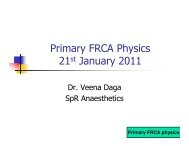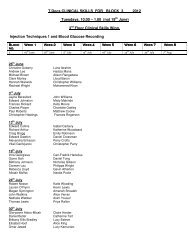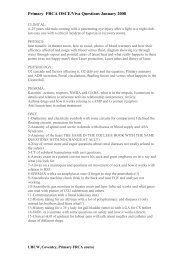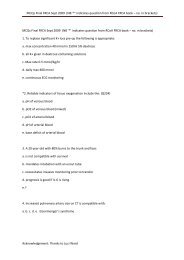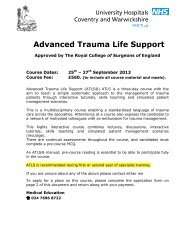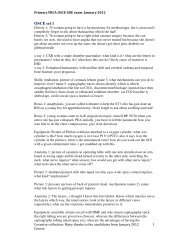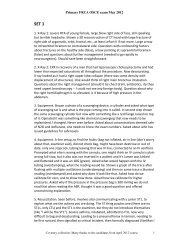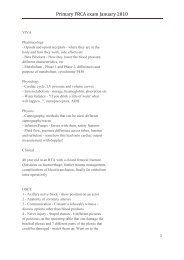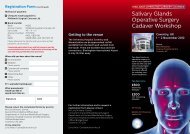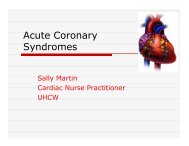Physics 2
Physics 2
Physics 2
Create successful ePaper yourself
Turn your PDF publications into a flip-book with our unique Google optimized e-Paper software.
Mass spectrometry
Mass SpectrometryRapid response timeMultiple gas analysisExpensivetoo bulkyAngle of deflectiondepends oncharge mass ratioCharge/massCharge/massO2CO2Enflurane
Blood gas analyser directly measuresPa O 2 , PaCO 2 and pH usingspecific electrodes . Membrane permeable to O 2 , CO 2,2, H +
Bicarbonate
2 electrodes Reference electrode : Ag /Agcl Measuring electrode: pH glass Electrolyte: NaHCO3, Kcl
CO 2 +H 2 O H 2 CO 3 H + +HCO 3-electrodesH+ glassMesh -HCO-3CO 2permeable teflon membrane
MeasuringelectrodeAg/AgClH+VReference electrodeAg/Agcl or calomel reference electrodeBufferH+ sensitive glassH+Kclleaky membraneVoltage change in the measuring electrode
CO2pHRef Elect Ag/AgCl Ag/AgclHg/HgclMeasuringElectrodepH glassElectrolyte Kcl,NaHCO3pH glassKcl
Excess heparin in the sample lowers the pHvalue Sampled blood can be stored at room temp forup to one hour pH is usually calculated using Siggard-Anderson nomogram CO 2 electrodes are maintained at roomtemperature CO 2 electrodes have a response time of 20secsTFFFFResponse time 2-323 minutes1 kPa = 30 minutes
2ml = 80 units of heparin
has CO2 sensitive glassuses sodium bicarbonate as electrolyteis an indirect method of measuringcarbon dioxide tensionis accurate to within 1mmHgis temperature-dependentFTTTTIndirect: 0.01 unit of pH change per 0.1 kPa CO 2
Fuel cell Clark electrode Paramagnetic oxygen anlaysers
Finite shelf-life=1yearcalibrationself generated voltageLead anodeKOHNo power supplyslow responsePb + 2OH -PbO + 2e- + 2H 2 OGold cathode
FiO 2 reading is not affected Life span of cell is affected(N 2 O reacts with lead anode)
polarising voltage 0.7 VAg/AgClanodeKClPlatinum cathode
AnodeAg + Cl = AgCl + e CathodeO2 + 2H2O + 4e = 4OH ElectolyteNaCl + OH = NaOH + ClElectrons donated at anode, consumed atcathode
Polarographic-platinum, AgclFuel cellClarkAnode Lead Ag/AgclCathode gold platinumElectrolyte KOHKcl, Nacl
Has a Gold cathodeHas a platinum anode (lead)Uses sodium hydroxide as theelectrolyte solution (KOH) Require a voltage of 6-767 volts appliedacross the electrodes (0.7 V for clark) Is affected by the presence of N 2 OTFFFT
a. Infrared analyser b. Raman spectroscopy c. Mass spectrometry d. Refractometer e. Quartz crystal TTTTF
pH Standard bicarbonate : SiggardnomogramSiggard-Anderson Carboxy haemoglobin Oxyhaemoglobin saturation: ODC Base excessFTFTT
a)measures Oxygen concentrationb)is the classical method of calibratingvaporisersc)is affected by water vapourd)does not require prior calibratione)is affected by temperatureFTTTTAll affected by water vapour except fuel cell
When sine waves of same frequency, amplitudeand phase are added, resulting sine wave willhave greater amplitude. If two sine waves are180 o out of phase, the resulting sine wave willhave zero amplitude and appears as straightline. Addition of sine waves in a variable degreeof out of phase will result in respective change inthe amplitude.
In a refractometer increased amplitude givesrise to bright fringe, reduced amplitude gives riseto dark fringe. There are two chambers. One isreference chamber and a sample chamber. Thechange in the phase of sine waves in the samplechamber and resultant displacement of fringepattern is dependent on the type andconcentration of the anaesthetic agent.
Is based on the principle that O2 is repelled by themagnetic fieldIs incorporated into the blood gas analysercan provide breath to breath measurementCan measure CO2Null deflection paramagnetic analyser has theadvantage of containing no moving partsFFTFF
sampleN2N2*Calibration% O2
sampleN2N2
Sample gasPulsed magnetic fieldReference gasDifferential pressure transducerSample gas with more oxygen attracted to the magnetic field& produces pressure difference across the transducer
4% 21% 5% 7% 0.3%FFTFF40 mm Hg x 0.13 = 5.3 kPa5.3 – 0.3 to 0.8 =4.5 to 5 kPa
Has a standard paper speed of 50mm/s.Has a Normal axis between +30 o to -90 oHas a maximal Q-Tc interval of 0.48s.Has a QRS duration of 0.08-0.12s.May have an inverted T wave in aVRFFFTTPR =0.12- 0.2, QT < 0.44, -30o to +90 oP= 0.1s, 2.5 mm,
a. applies to both electromagnetic radiation andsoundb. changes the velocity of reflected soundc. is based on the piezo-electric electric properties ofcrystalsd. shows the shift to lower frequency if the sourceis moving away from the receivere. can indicate the velocity of red cellscTFFTT
A lower signal to noise ratio is better than ahigher ratioDiagnostic mode in the ECG monitor has afrequency response of 0.5 to 40 HzCM5 configuration is ideal for detectingarrhythmiaSignal to Noise ratio can be improved by usingfilters.Differential amplifier can reduce the electricalinterferenceFFFTT
12. Concerning ECG Monitoring A high signal to noise ratio is better than ahigher ratio Monitoring mode in the ECG monitor has afrequency response of 0.5 to 40 Hz Diagnostic mode 0.05 5 to 100 Hz. CM5 configuration is ideal for detectingischaemia Signal to Noise ratio can be improved by filters
Right arm = red = C ManubriumClavicle =Neutral = greenLeft arm = yellow = V5 positionSelect lead 1Monitoring mode : 0.5 - 40 HzDiagnostic mode: 0.05 -100Hz : ST segment, QRS not distorted
Amplifier amplifies the signal before it is displayed on themonitor.A differential amplifier measures the difference between thepotential from two sources. Any interference which iscommon to the input terminal such as 50Hz mainsfrequency is eliminated. This rejection of common inputfrequency is known as common mode rejection.
Nail varnishMethylene BlueTricuspid incompetenceMethaemoglobinCarboxyhaemoglobinTTTTT
accuracy : +/-2%, >70%: +/-3% 50-70%HypoperfusionAmbient lightFluorescent, xenonMovementsDiathermyNo effectHbF, HbS, Bilurubin, anaemiaAcrylic nails.External dyes, Nail varnish (black/green)Abnormal haemoglobinsHbMet, HbCO,Indocyanine green, Methy. blue
a. Nitrous oxideb. Oxygenc. Heliumd. Entonoxe. Medical air T FFFF
a. Nitrous oxide: 36.5 o Cb. Oxygen: -118.4o Cc. Helium:d. Entonox: -7 o Ce. Medical air: -140o C
15. Regarding measurement of Gas flowExamples of Constant Orifice/Variable Pressuredevices includePneumotachographPeak flow meterRotameterPitot tubeWright respirometerTFFTF
Gas flow & Volume measurement Pneumotachographfixed orifice, variable pressure drop, Q = P/R- Fleisch Pneumotachograph- Screen Pneumotachograph- Pitot tube Pneumotachograph- Hot wire Pneumotachograph Peak flow metervariable orifice, fixed pressure drop flow meter
Gas flow & Volume measurementQ = P/R Direct measurement of volumeSpirometer & Wright Respirometer Variable orifice- constant pressure dropRotameter, Peak flowmeter Fixed orifice- variable pressure dropPneumotachograph, Pitot tube.
16. The concentration of isoflurane in abreathing system can be measured using a. Mass spectrometer b. Paramagnetic analyser c. Refractometer d. Infrared analyser e. Ultrasonic analyser : velocity of sound T FTTT
The composition of isothermal binary-gasmixtures can be determined by measuringthe velocity of sound in the gas
17. Flow can be measured byThe Fick principleHigh frequency sound wave reflectionChange in temperature of a hot wirePressure drop across a constrictionVenturi effectTTTTT
Fick principle:blood flow to any organ = Qx / [Ax-Vx]Inhaled nitrous oxide is used. Qx: amount of substance removed by theorgan Ax: arterial conc. Vx: venous concentration
18. Flow meters in anaesthetic machinesN2O can be used in an O2 flow meter withoutchanges in calibrationAre variable orifice variable pressure devicesUses a straight tube and a bobbinHave a linear scaleBoth Laminar and turbulent flows are encounteredFFFFTN2O, CO2 = MW =44, density similar =1.997 mg/cm3 at0 o CViscosity =1488 poise at 27 o C, CO2 ?LV HD
19. Rota meters in anaesthetic machines Have an accuracy of about 2% Are calibrated at 37 o C and a pressure of 101.3kPa Reading should be taken from the bottom ofthe bobbin Are gas specific At low flows, viscosity play important roleLV, HDTFFTT
Flow meters vs Altitude Q =Pr 4 /nl = √P/ P/ρlHigh pressure = false high reading, over -readsLow pressure = false low reading, under-readsBack pressure ~ under-readsreadsLV, HD
20. Distribution of ventilation ismeasured bya. Helium dilution techniqueb. Body plethysmographyc. Nitrogen wash outd. radioactive xenone. . 100% oxygenFFFTF
20 Radioactive albumin : Perfusion Radioactive gas (xenon)
21. Wrights respirometer may give a lowreading whena) high tidal volume is used (overb) FiO2 = 0.3c) Nitrous oxide is usedd) Humidification is usede) mechanical ventilation is used (overdue to high peak flow at the beginning)(over-reads) reads)(over-reads readsUnder-reads reads at low flows. Over-reads reads at high flow
Wright’s s respirometer is a turbineflowmeter A series of tangential slits that causecircular motion of the gas flow thatproduces rotation around the vane The vane does not rotate when the flow isreversed The composition of gas used does notinfluence its performance Under-reads reads at low flow and over reads athigh flow
22. Pulse oximeter probes[a] Emit near infra-red red light.[b] Once calibrated, do not need re-calibrating.[c] Can cause heating of contact tissues.[d] Are damaged by mild detergents.[e] Are rendered inaccurate by 70% isopropylalcoholF T T F F
23. Pneumotachographa. measures laminar flowb. measures the pressure differencec. is more accurate if heated to aconstant temperatured. can be used to measure the volumee. it shows a linear response onlywithin the calibration rangeT T T T T
Measures Flow, volume = flow /time
24. Regarding Temperature andHeat1. Absolute zero is -273K2. Boiling point of water is +373K3. Water freezes at +273K4. SI unit of temperature is calorie5. Daltons law states that Volume variesdirectly with temperatureFTTFF
24. Regarding Temperature andHeat1. Absolute zero is -273 C or 0 K2. Boiling point of water is + 373K3. Water freezes at +273K4. SI unit of temperature is Kelvin5. Daltons law states that Volume variesdirectly with temperature0 o C = 273 K
Gas laws Daltons: In a mixture of gases, pressureexerted by each gas is same as that whichit would exert if it alone occupied thecontainer.
Absolute ZeroFreezing pointH2OBoiling point0K -273C-459F273K0C32F373K 100C212FK=C+273C=5/9(F-32)F=9/5(C+32)
25, Invasive blood pressurea. is higher in dorsalis pedis artery as comparedto brachial artery in supine position b. Requires a system pressurised to 300kPa(mm Hg)c. records a higher systolic pressure ascompared to NIBPd. is unreliable in hypertensive patiente. Records a more accurate mean arterialpressure as compared to NIBP
Factors affecting damping fn = √D 2 ./pLCfn = natural frequency ,D = diameter of catheter,p = density,L =length,C = compliance.
Resonance and damping Inertial forces : mass Elastic forces: spring Friction forces: mediumMass –spring system Fluid Diaphragm Viscous effect of fluid•fn =√D 2 ./pLC
Resonance and dampingSquare wave testD 2 /D 1 = 5 /10 =0.5300 mmHgAmplitude ratio = D. coeffD2D11 cycle,; fn = speed / 1 cycle (mm)
Stiff tube, diaphragmThe loss of pressure in the bag, complianttubing, stopcocks, length >120 cm, kinkingof the cannula, blood clots and air bubbles
Critical damping= no oscillations, noovershoot. Under-damped damped more than 3 cycles beforereaching zero. Amplitude ratio of 0.1 = optimum damping= damping coefficient 0.6 -0.7, 0.64 fn = √D 2 ./pLC increased compliance reduces naturalfrequency
a) 7.5 mm Hg is equivalent to 10 cm H 2 O b) ) 1 kPa is equal to a pressure of 7.5 mmHg c) ) 1 bar is equal to 15 psi d) ) A mercury barometer used to measureatmospheric pressure is sealed with avacuum above the surface of the liquid e) ) Aneroid gauges do not contain liquid
Atmospheric pressure1 bar = 15 psi =1000cm H 2 0 =750 mm Hg=100kPa1 psi =6.89 kPa
a. is dependent on the viscosity of the fluid b. doubles if the radius of the cannula is doubled c. doubles if the length of the cannula is halved d. is inversely proportional to the length of thecannula e. doubles if the pressure is doubled. TFTTT Q is proportional to the r 4 Q =P r 4 /nl
28. With regard to accidentalelectrocution(a) The risk of ventricular fibrillation increases withincreasing current frequency.(b) The risk of ventricular fibrillation is greater withalternating current.(c) The use of battery operated equipment avoids therisk of ventricular fibrillation.(d) The risks of electrocution is reduced by earthingthe patient.(e) All electrical equipment in the operating theatreshould be earthed (battery(operated).FTFFF
29. a) The blood gas results are normal to thispatient b) An echocardiogram would be useful. c) A ventilation perfusion scan would be helpfulin diagnosis d) An intrapulmonary shunt is accountable forthese findings e) An increased dead space is accountable forthese findings. FTTFT
30.With respect to statisticsNull hypothesis states that there is no realdifference between two sets of dataRejection of the null hypothesis leads toacceptance of the alternate hypothesisBeta error occurs if the null hypothesis iswrongly rejected.Alpha error states that the null hypothesis hasbeen wrongly acceptedPower of a study can be increased by raisingthe number of observationsTTFFT
BJA, CEACCP The null hypothesis would therefore bethat intra-articular articular morphine is no betterthan placebo. A type I error ( alpha) occurs when thenull hypothesis is incorrectly rejected. Atype II error (beta) occurs when the nullhypothesis is incorrectly accepted
GOOD LUCK



